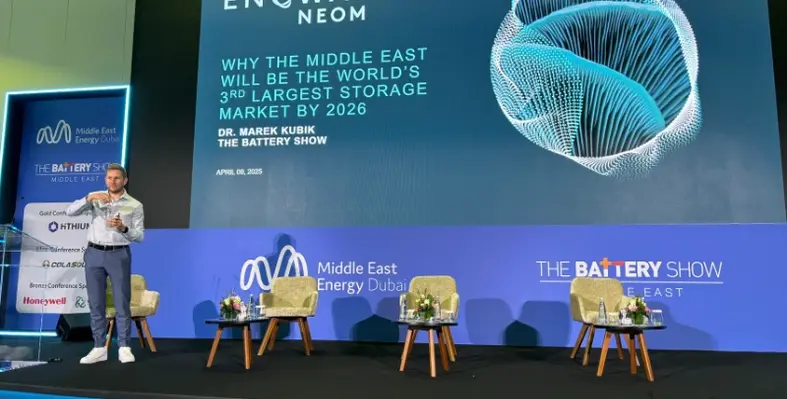Dr. Marek Kubik, director of battery energy storage systems (BESS) at Enowa.Neom, delivered a groundbreaking presentation revealing the explosive growth of energy storage in the Middle East.
The presentation was delivered at The Battery Show in Dubai, co-located with Middle East Energy last week. It took place from 7-9 April at the Dubai World Trade Centre.
Kubik’s insights paint a picture of a region on the cusp of a renewable energy revolution, saying that the Middle East could be the third largest storage market in the world by 2026.
Kubik began by introducing Neom, a visionary economic development project in northwestern Saudi Arabia spanning an area comparable to Belgium.
"Neom is not a giga-project or a city," he emphasised, "it's an economy building exercise."
The region aims to accommodate Saudi Arabia's young population, with 70% under 30 years old, and create a sustainable future powered entirely by renewable energy.
Trends in battery technology and cost reductions
The presentation highlighted remarkable trends in battery technology. Kubik explained how battery costs have plummeted, with cell prices dropping to around US$40-US$50 per KWh.
"Unlike conventional energy infrastructure, batteries are electrochemistry," he noted, "which means very steep learning rates similar to solar technology."
Most striking were the energy storage project developments in the region. Kubik revealed that contrary to global forecasts, the Middle East is rapidly becoming a major player in battery storage.
Future projections and use cases for Neom
He showcased several significant projects, including a 19 GWh installation in the UAE and Saudi Electric Company's 2.6 GW battery project - currently the world's largest single-phase battery installation.
He also highlighted Red Sea Global’s projects in Saudi Arabia, stating, “This is actually a collection of best projects that are operational, and there are six sub clusters.”
"Just take the projects in the MENA region," Kubik stated, "and you can see it's already jumping to number three globally."
His bottom-up analysis suggests the region's energy storage capacity is significantly underestimated by current forecasts.
A key innovation Kubik highlighted is Neom's approach to grid design.
By integrating renewable generation with battery storage, they can dramatically reduce transmission infrastructure.
"Instead of building a 6 GW transmission line, we can build a 2 GW line," he explained, demonstrating substantial cost and infrastructure savings.
The presentation concluded with a powerful message about the future of energy storage.
With rapidly improving battery technology, longer duration systems becoming economically viable, and massive regional investments, the Middle East is positioning itself as a global leader in renewable energy transformation.
Kubik's insights reveal a region not just adapting to the renewable energy revolution, but actively driving it forward, with battery storage playing a pivotal role in this sustainable future.







